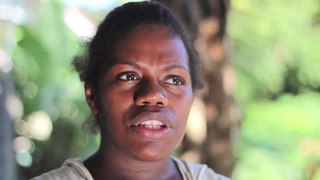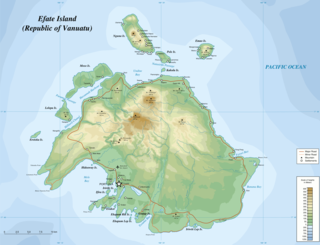
Bislama is an English-based creole language. It is the national language of Vanuatu, and one of the three official languages of the country, the other ones being English and French. Bislama is the first language of many of the "Urban ni-Vanuatu" and the second language of much of the rest of the country's residents. The lyrics of "Yumi, Yumi, Yumi", the country's national anthem, are composed in Bislama.

Efate is an island in the Pacific Ocean which is part of the Shefa Province in Vanuatu. It is also known as Île Vate.
The Central Vanuatu languages form a linkage of Southern Oceanic languages spoken in central Vanuatu.

The Republic of Vanuatu has the world's highest linguistic density per capita. Despite being a country with a population of less than 300,000, Vanuatu is home to 138 indigenous Oceanic languages.
Mwotlap is an Oceanic language spoken by about 2,100 people in Vanuatu. The majority of speakers are found on the island of Motalava in the Banks Islands, with smaller communities in the islands of Ra and Vanua Lava, as well as migrant groups in the two main cities of the country, Santo and Port Vila.

Alexandre François is a French linguist specialising in the description and study of the indigenous languages of Melanesia. He belongs to Lattice, a research centre of the CNRS and École Normale Supérieure dedicated to linguistics.
Mota is an Oceanic language spoken by about 750 people on Mota island, in the Banks Islands of Vanuatu. It is the most conservative Torres–Banks language, and the only one to keep its inherited five-vowel system intact while also preserving most final vowels.
Lakon is an Oceanic language, spoken on the west coast of Gaua island in Vanuatu.
Mwerlap is an Oceanic language spoken in the south of the Banks Islands in Vanuatu.
Mele-Fila (Ifira-Mele) is a Polynesian language spoken in Mele and Ifira on the island of Efate in Vanuatu. In spite of their differences, Mele and Fila are two dialects of the same language and are mutually intelligible. French and English are also fairly common among the residents of Efate.
Sungwadaga or Central Maewo, also known as Peterara after one of its dialects, is an Oceanic language spoken on Maewo, Vanuatu.
Malua Bay is an Oceanic language spoken in northwest Malekula, Vanuatu. It has two main dialects: one spoken in Malua Bay and the other spoken in Espiegles Bay.
Darrell T. Tryon was a New Zealand-born linguist, academic, and specialist in Austronesian languages. Specifically, Tryon specialised in the study of the languages of the Pacific Islands, particularly Vanuatu, the Solomon Islands, and the French-speaking Pacific.
Nisvai is an Oceanic language spoken in southeast Malekula, Vanuatu, on the eastern tip of the island, by about 200 speakers.
Nasvang is an Oceanic language spoken in southeast Malekula, Vanuatu, by about 275 speakers.
The Malakula languages are a group of Central Vanuatu languages spoken on Malakula Island in central Vanuatu. Unlike some earlier classifications, linguist and Oceanic languages specialist John Lynch (2016) considered the Malakula languages to form a coherent group.
Rutan is a Malakula language of Vanuatu.
Alovas is a Malakula language of Vanuatu.
Najit is a Malakula language of Vanuatu, spoken by less than 5 speakers.
Njav is a Malakula language of Vanuatu. There are about 10 speakers.




